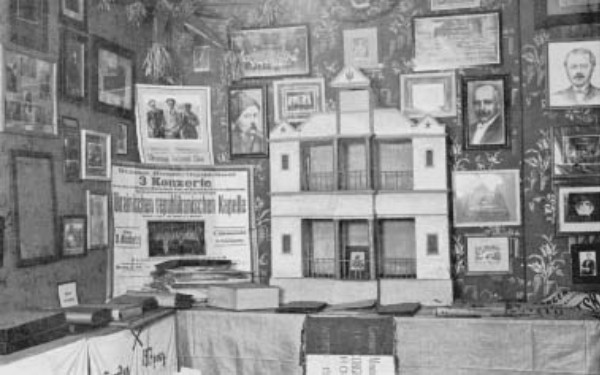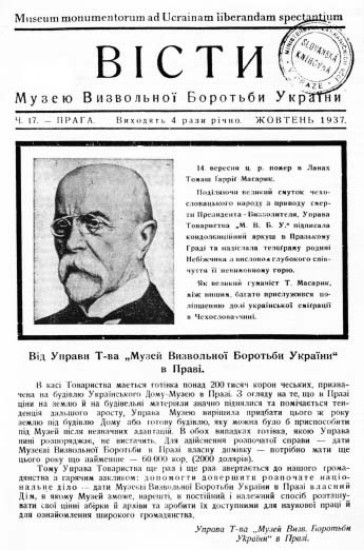Museum of Ukraine's Struggle for Independence
Museum of Ukraine's Struggle for Independence [Музей визвольної боротьби України; Muzei vyzvolnoi borotby Ukrainy]. A repository in Prague of books, artworks, artifacts, and archives of the Ukrainian struggle for independence (1917–20) voluntarily deposited by Ukrainian émigré figures and organizations. The museum was founded in 1925 by a group of Ukrainian war veterans and professors at the Ukrainian Free University. It was funded solely by donations, mostly from the United States, Canada, and from Yakiv Makohin of the Ukrainian Bureau in London; the main benefactor from 1929 to 1939 was Kalenyk Lysiuk. The museum was owned by a society (140 members in 1943) headed by Ivan Ya. Horbachevsky (1925–35), Stepan Smal-Stotsky (1935–8), Andrii Yakovliv (1939–?), and Dmytro Doroshenko (?–1945). Dmytro Antonovych served as the museum’s director from the time of its founding until his death in 1945; the museum’s operations were then taken over by assistant director Symon Narizhny, who for years had been handling its routine affairs. The museum published its own bulletin, Visty, irregularly in 1925–36 and then quarterly.
The museum’s collection was initially exhibited in three and then six rented rooms, with the remainder of the holdings kept in three garages. A building to house the museum was bought in 1938, only after enough money had been raised. It opened in 1939 after its renovation.
The museum had invaluable archival holdings, including the papers of various diplomatic missions of the Ukrainian National Republic, the Union for the Liberation of Ukraine, the Ukrainian Sich Riflemen, Ukrainian prisoner of war camps in Germany during the First World War, Ukrainian internment camps in Poland and Czechoslovakia after the war, and the Ukrainian Republican Kapelle; literary manuscripts, and the correspondence of figures such as Oleksander Barvinsky, Mykola Yevshan, Bohdan Lepky, Yaroslav Vesolovsky, and Metropolitan Vasyl Lypkivsky. It had an impressive art collection (paintings and over 1,400 engravings donated by émigré artists and collectors); sets of approximately 1,200 Ukrainian periodicals; a Ukrainian numismatic and currency collection; a collection of Ukrainian military uniforms, arms, army photos, documents, and reports; and a large library consisting of over 70 book collections (including those of Dmytro Antonovych, Ahenor Artymovych, Vasyl Bidnov, Spyrydon Cherkasenko, Bohdan Lepky, Kost Matsiievych, Ivan Mirny, Oleksander Kolessa, and Stepan Smal-Stotsky), antique maps of Ukraine, J.B. Homann's Atlas Novus (1716), and a collection of calendars.
In February 1945 the museum was hit by an Allied bomb, and its offices and a quarter of its holdings were destroyed. The surviving materials were moved and stored in the basement of the Klementium (the location of the National and University libraries) and the Ministry of Internal Affairs. Not long thereafter following the Red Army’s occupation of Prague in May 1945, the museum collection was confiscated by Soviet agents. Ownership was restored to the museum’s executive council through the efforts of Symon Narizhny, and from November 1945 the museum functioned tentatively as the Ukrainian Museum. At that time it was headed by Yu. Dobrylovsky and Kornylo R. Zaklynsky.
In March 1948 the Czechoslovak government closed down the museum and confiscated its holdings. A large part of the archive was taken to Kyiv and and placed in various special collections (see Sptesfondy). A certain amount of material was also carried off to Moscow, Lviv, and regional archives in Ukraine. The Slavonic Library in Prague received most of the museum's library holdings. A substantial number of books and artifacts were donated to the Cultural Association of Ukrainian Workers in the Prešov region, where they eventually found their way (albeit in a much diminished number) to the Svydnyk Museum of Ukrainian Culture. Symon Narizhny sought to mobilize Ukrainian opinion in the West to protest the fate of the museum. However, his efforts in this regard were undercut by Kalenyk Lysiuk, the museum’s former benefactor, who accused Narizhny in the North American Ukrainian press of having handed over the museum’s collections to the Soviets in 1945. The story of the museum’s post-1948 history was pieced together by Mykola Mushynka, who published his findings along with a general historical overview as Muzei vyzvol’noï botot’by Ukraïny ta dolia ioho fondiv (English title: The Museum of the Ukrainian Independence Movement and the History of Its Collections, 1996).
Arkadii Zhukovsky
[This article was updated in 2008.]


.jpg)